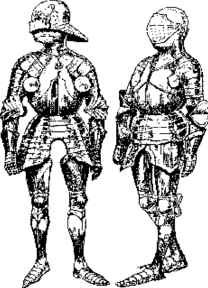Tournaments (2)
In the chivalric tradition, Elizabeth played the role of the virgin for whose honour and favour knights in armour* fought, and tournaments early in her reign were often fought by courtiers vying for her attention. Among the more famous combatants were Sir Philip Sidney and the Earl of Essex. In later years, James I* and his sons also participated in tournaments.
Tournaments provided a show of national unity, military power and the wealth of the monarchy -- although the cost was usually borne by the individuals involved, rather than by Elizabeth herself. More money was spent on tournaments in the Elizabethan period than on masques, plays, or pageants. They were held to mark visits of foreign dignitaries and there was an annual tournament on November 17th in celebration of Elizabeth's accession to the throne.
Click to hear a ceremonial fanfare.*
Footnotes
-
James I and later
James I was an active participant in tournaments, fighting in 1606, 1609 and 1613. His sons, Henry and Charles, were also tournament favourites. Henry, the eldest, was especially popular, and became a kind of cult figure. He made his debut at the Twelfth Night tournament in 1610, and with six aides fought fifty-six opponents in foot combat. His untimely death in 1612 ended a short-lived, and promising career.
The last known tournament in England was held in 1625 to celebrate the marriage of Charles I to Henrietta Maria of France.
-
Renaissance ceremonial armour
By Shakespeare's day, armour was no longer effective on the battlefield; the armour illustrated here was worn on ceremonial occasions.
-
The fanfare
This fanfare, part of which is available on the home page of this program, was written somewhat after Shakespeare's death, by Henry Lawes, for a Restoration Court masque.
